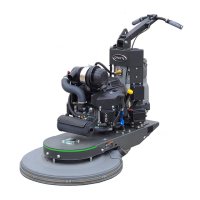46 47
UNDERSTANDING FACTORS THAT DETERMINE
CARBON MONOXIDE LEVELS
This table shows the calculated equilibrium carbon monoxide level under dierent examples with
varying inputs:
Example
No.
Qty of
Engines
CO in
Exhaust
(PPM)
Exhaust
Flow per
Engine
(CFM)
Total CO
Production
Rate (CFM)
Air
Exchange
Rate (ACPH)
Air Ex-
change
Time
(min)
Room Air
Volume,
ft3
Room
CO Level
(PPM)
1 1 50 13 0.00065 3 20 80000 0.163
2 5 50 13 0.00325 3 20 80000 0.813
3 5 50 13 0.00325 3 20 80000 8.13
4 5 50 13 0.00325 1 60 80000 24.4
5 5 500 13 0.0325 1 60 80000 244
There are several important notes to take away from these calculations:
• More engines running in a space leads to higher room CO level. This is shown comparing Examples
No. 1 & 2.
• Smaller room size leads to higher room CO level. This is shown comparing Examples No. 2 & 3.
• Lower ventilation (Air Exchange Rate) leads to higher room CO level. This is shown comparing
Examples No. 3 & 4.
• Higher CO level in the exhaust leads to higher room CO level. This is shown comparing Examples
No. 4 & 5.
DANGER: Operating this machine or any propane powered engine in a space with NO
ventilation (a sealed space), is guaranteed to result in dangerously high level of CO, that will
cause serious injury or death to the operator and bystanders. Never operate the machine in
a sealed space with no ventilation.
METHODS TO REDUCE CARBON MONOXIDE EXPOSURE
Reviewing the above section, we already know that to reduce CO exposure the following action should
be taken:
• Limit the quantity of engines running in a space.
• Insure adequate ventilation. Higher ventilation rates (higher air exchange rate) will always result in
lower CO exposure.
• Insure proper maintenance and performance of engine to avoid high CO content in engine exhaust.
• All of these tips are especially important to follow when using the machine in small spaces.
This section oers additional considerations and best practices to reducing Carbon Monoxide exposure:
• Air Exchange and CO Diusion
• Application Considerations
• Examples of CO Management in Spaces
• Maintenance of Equipment
METHODS TO REDUCE CARBON MONOXIDE EXPOSURE
The most reliable method to prevent CO Poisoning is to ensure all the CO produced is vented
outside. With wood stoves or gas heaters this is performed with ductwork that carries the
exhaust and CO outside. Non-stationary combustion type equipment must be used in such a way that CO
is not allowed to rise to a harmful or dangerous level. CO does not readily dissipate or mix with air on its
own. Air currents can “stir” the CO and dilute the concentration or ppm values by mixing it with the avail-
able air. When using equipment over a large area in a short time
“stirring” occurs as you walk, or to say it another way, your Eective Operating Zone is large. When activity
is concentrated to a smaller area as in a stripping application, the Eective
Operating Zone is small, and “stirring” must be forced by the use of fans to increase the
Eective Operating Zone and reduce high concentrations of CO. “Air” exchange rates (air
exchange is dened as the exhausting of internal air to the external atmosphere), the size of the Eective
Operating Zone, amount of CO produced, level of human activity, and the duration of exposure are all
factors in the determination of the production of carboxyhemoglobin and the amount of CO blood satura-
tion.
AIR EXCHANGE AND CO DIFFUSION
Dierent types of work (applications) present varying risk of CO exposure. The highest risk is associated
with types of work that require slow movement, such as oor stripping or polishing. Due to slow move-
ment, the activity and engine exhaust is concentrated to a relatively small area which results in higher CO
levels for the operator. Types of work that require high movement, such as burnishing, will naturally stir the
air and diuse the engine exhaust and result in lower CO levels for the operator.
The term “Eective Operating Zone” is used to visualize this concept. The Eective Operating Zone can be
dened by the amount of area covered during a given time frame. Small Eective Operating Zones result
the greatest risk of CO Exposure.
When using equipment over a large area in a short time, as in most burnishing applications, your Eective
Operating Zone is large. When activity is concentrated to a smaller area as in stripping applications, the
Eective Operating Zone is small and stirring or CO mixing MUST be forced by the use of fans to increase
the Eective Operating Zone and reduce high concentrations of CO. The Eective Operating Zone can be
dened as the area covered in a given time.
TYPE OF WORK CONSIDERATIONS

